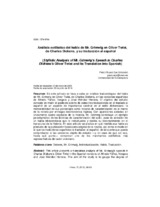Análisis estilístico del habla de Mr. Grimwig en Oliver Twist, de Charles Dickens, y su traducción al español
Stylistic Analysis of Mr. Grimwig’s Speech in Charles Dickens’s Oliver Twist and Its Translation into Spanish
Autor
Ruano San Segundo, Pablo
Editor
UCOPressFecha
2016Materia
Dickens, Charles, 1812-1870Mr. Grimwig
Individualización
Habla
Traducción
Individualization
Speech
Translation
METS:
Mostrar el registro METSPREMIS:
Mostrar el registro PREMISMetadatos
Mostrar el registro completo del ítemResumen
En este artículo se lleva a cabo un análisis traductológico del habla de Mr. Grimwig en Oliver Twist, de Charles Dickens, en las versiones españolas de Alfredo Yáñez, Vergara y José Méndez Herrera. El objetivo del estudio consiste en medir el grado de acierto de estas tres traducciones en el traslado al español de un aspecto de importancia cardinal en el estilo dickensiano: la memorabilidad de sus personajes como recurso de caracterización en el marco de la novela por entregas decimonónica inglesa. Con apariciones aisladas en únicamente cuatro capítulos de la historia, Mr. Grimwig constituye un ejemplo paradigmático de las técnicas de caracterización del autor, pues es acreedor de un habla idiosincrásica que le individualiza y facilita su reconocimiento en el transcurso de la historia. En este artículo se analiza en qué medida esa habla es producto de la publicación fasciculada original de la novela, así como el modo en el que los traductores españoles la trasladan al español, de tal suerte que pueda comprobarse si las versiones objeto de estudio —y en caso de que así sea, hasta qué punto— conservan uno de los marchamos estilísticos más representativos del autor victoriano. This article presents a translation analysis of Mr. Grimwig’s speech in Charles Dickens’s Oliver Twist in the Spanish versions of Alfredo Yáñez, Vergara and José Méndez Herrera. The aim of the study is to gauge the degree of faithfulness of these three translations in rendering into Spanish one of Dickens’s best-known stylistic features: his characters’s memorability as a typical characterizing device of nineteenth-century English serialized fiction. With appearances in only four chapters of the story, Mr. Grimwig constitutes a paradigmatic example of Dickens’s celebrated techniques of characterization. This character possesses an idiosyncratic way of speaking, which singles him out and helps the reader to recognize him in the course of the story. In this article, I will analyze if this way of speaking is a stylistic outcome of the serialized mode of publication in which Oliver Twist was originally released and how translators render it into Spanish. Thus, it will be possible to conclude whether and to what extent the three versions under analysis here maintain one of the Victorian author’s most distinguished stylistic features

